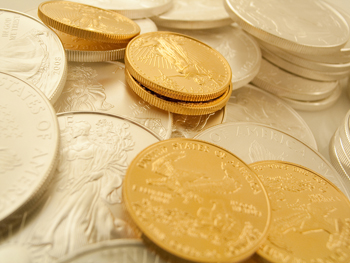 About a week ago, gold was struggling to stay above $1,250 an ounce. Without looking too hard, you could find plenty of investment gurus who were of the opinion that precious metals were nowhere near a bottom, and that prices would continue to fall. Well, a lot can change in a week. On June 19, 2014, gold prices shot up $41.80, or 3.3 percent to settle at $1,314.10 on the NY Mercantile Exchange. July silver had an even more impressive 4.4 percent gain for the day, settling up 87 cents to end at $20.65. Analysts generally agreed that the big move in gold and silver was due to favorable comments by the Fed and unfavorable developments in Iraq.
About a week ago, gold was struggling to stay above $1,250 an ounce. Without looking too hard, you could find plenty of investment gurus who were of the opinion that precious metals were nowhere near a bottom, and that prices would continue to fall. Well, a lot can change in a week. On June 19, 2014, gold prices shot up $41.80, or 3.3 percent to settle at $1,314.10 on the NY Mercantile Exchange. July silver had an even more impressive 4.4 percent gain for the day, settling up 87 cents to end at $20.65. Analysts generally agreed that the big move in gold and silver was due to favorable comments by the Fed and unfavorable developments in Iraq.
While no one day confirms a long-term trend, the explosive day for both gold and silver may turn out to be just the impetus needed to send precious metals higher. If you look back in six months or a year from today, it may become perfectly clear that you should have invested in gold and silver bullion on June 18, 2014, before prices surged. Clearly, major announcements or world events can temporarily spike precious metal prices, but there are other factors at play that are signaling gold and silver are bottoming out.
From a technical aspect, the charts look very bullish. In an article by Michael Lombardi on Profit Confidential, the author points out two important technical indicators that support the position of a strong market bottom forming in precious metals. First, the gold charts show a double-bottom formation that indicates strong technical support for gold at $1,200 per ounce. In July and December of 2013, gold prices came close to $1,200 and then rebounded over the next several months to more than $1,350 per ounce. Second, the $GVZ Index that measures the volatility of gold prices, has dropped down to 14 in May of 2014. When gold was hitting its lows in July of 2013, the volatility index was 32. When it hit the second bottom in December of 2013, the volatility index was about 22. When long-term gold and silver bullion investors see large fluctuations in day-to-day prices, the fear of buying at the wrong price, keeps them away. When volatility calms down and the precious metals market becomes more orderly, people feel more comfortable buying physical gold and silver.
Joe Foster, a fund manager at Van Eck Associates, believes that a solid floor for gold has been put in at $1,200 per ounce. According to Joe Foster, loosened import and tax restrictions in India will create more demand in the world gold market. He also notes that exchange-traded precious metal funds have stabilized and that is a bullish signal for the future.
Technical indicators suggest that gold and silver prices have bottomed-out. Evidence is starting to show that inflation is back and may only get worse. People are afraid that the civil war in Iraq will cause major problems with the economy. When you look ahead to the rest of 2014, and 2015, all of the signs point to gold and silver doing very well.
